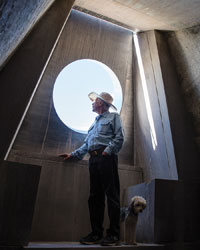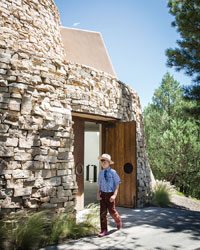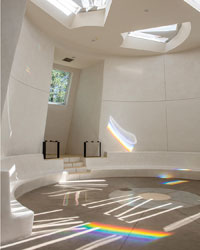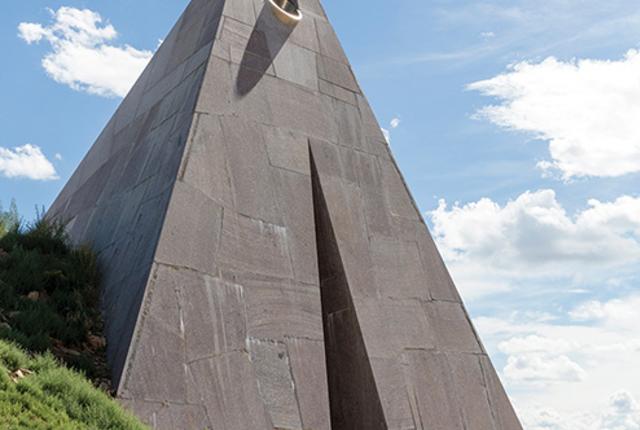(above) Decades in the making, the artwork is still under construction
and not open to the public.
 Charles Ross and his dog Pi atop Star Axis’ central staircase.
Charles Ross and his dog Pi atop Star Axis’ central staircase.
AND SO THEY CAME WEST. A handful of New York artists, sculptors mostly, picked up on an idea that was buzzing around the Dwan Gallery on West 57th Street in the late sixties: What if their medium were not wood or glass or anything that could be easily shown and sold to collectors, but the earth itself? They would need land that was both striking and abundant, where they could make large-scale art to last.
Robert Smithson went to Utah and built the Spiral Jetty, a walkable butterfly tongue of dirt and rock curling out into the blood-red littoral of the Great Salt Lake. Michael Heizer returned to the Nevada moonscapes of his youth to make ambitious pieces like Double Negative, an earthwork carved from the lip of a mesa, and City, a massive sculptural complex, under construction since 1972, that President Obama this year declared a national monument.
In New Mexico, Walter De Maria staked out a one-mile-by-one-kilometer tract near Quemado with an evocative grid of 400 metal poles, as tall as 26 feet, whose tops form a level plane. Since its opening in 1977, The Lightning Field has drawn visitors from around the world, no more than six at a time. They stay overnight at the site, hoping for a summer thunderstorm to strike or simply wandering out into the work to study the interplay of land, light, and stainless steel.
“The landscape and the open spaces that were available were, in some regard, unique to this part of the world. And the light, too—the light in New Mexico is incredibly particular and very fine,” says the documentarian James Crump. His new film about the land art movement, Troublemakers, will be shown this fall in Santa Fe. He continues, “The journey to get to this place in a far-out, isolated area—that was intended to be part of the work itself. And that’s what’s so nice about New Mexico: You can still do that, go out and drive for miles and hardly see any automobiles at all.
At the same time that De Maria was at work on The Lightning Field, a fellow Dwan Gallery artist named Charles Ross broke ground on a mesa overlooking a cattle ranch on the other side of the state. Long interested in starlight, Ross had become fascinated by an astronomical phenomenon called precession. Due to the slow wobble of the earth’s top-like twirl, the star Polaris, which at present appears mysteriously fixed above the North Pole, in fact undergoes a 26,000-year cycle during which its circular course in the night sky widens from almost nil to circumnavigating a person’s entire focused field of vision, then returns to a near standstill.
“I quickly realized that this precessional cycle had a human dimension to it, and that interested me. I didn’t want to just know about that; I wanted to be able to walk through it,” Ross says. The plan was simple at first: He would build a staircase atop a hill, with a circular cutout at the top, centered on the polestar. As viewers ascend the stairs along the axis of the earth, the circle frames bigger and bigger swaths of sky, outlining Polaris’ path in years both past and future. Partway up, they can see the scope of its rotation at the time the Egyptians were building pyramids. Back then, a different star, Thuban, would have twinkled in the eye of the circle, marking true north. By the time visitors near the top of a ten-story climb, each heavy, panting step expands time by thousands of years, until finally the steel circle marks the limit of Polaris’ part in what Ross calls “the dance of the spinning earth among the stars.”
The central idea of the piece, which is titled Star Axis, hasn’t changed since the early seventies. But when Ross picked out a mesa in a place with just the right balance of land, sky, and naked horizon, he made one crucial adjustment. A dream had convinced him that instead of building a freestanding staircase, he had to “enter the earth to reach the stars,” lowering what he calls the Star Tunnel into the land. That meant serious excavation. He quarried sand-stone from an adjacent hillside to reinforce the concrete structure, and capped it with granite at angles precisely aligned to equinoctial sunlight and the celestial equator. It was endless, painstaking labor, but the result began to feel as inevitable as the ancient observatories that inspired it.
Forty years later, he’s still hard at work. Practically nothing on an astronomical timescale, granted, but here on earth things have changed. Ross’ sharp green eyes are offset now by bristly white hair, his skin weathered by so many summers in the New Mexico sun. In 1985, he told an interviewer that Star Axis’ “site is isolated, yet there is civilization whispering in the background.” The whispers grow ever so slightly louder. Though his mesa remains “probably about as dark as it can be in the United States,” Ross says, he can detect faint“ bubbles of light” from cities as far away as Albuquerque, a hundred miles west. During the day, a person halfway up Star Axis’ granite staircase can turn around and see a row of wind turbines silhouetted on the southern horizon, looking for all the world like curious new sculptures measured out along the plateau.
Land art is an elusive term. Though it’s commonly associated with the movement started by the Dwan Gallery crowd, they’re hardly the only artists to make art from and of the earth. “Stonehenge was there before any of them,” the artist Carl Andre points out in Troublemakers. “Earthworks are an older tradition than oil painting by three thousand years.”
In recent decades, there has been a shift away from the monumental sculptural work of the likes of Ross and Heizer. “Our culture’s changed. I don’t know that people feel it’s right to just go out and mark the land like that,” says Jeanette Hart-Mann, a professor at the University of New Mexico’s Land Arts of the American West program. She calls the Dwan artists’ work “important” but prefers a broader definition of land art that attends to things like environmental and border issues. The program makes outings to sites such as Chaco Canyon and the Gila National Forest, where one student developed a conceptual piece based on her frustration with trying to identify the boundary of the wilderness.
The common ground lies in what Hart-Mann calls “the ecology of place,” something that others describe in more mystical terms. “The place, the specific site, the fact that it’s in New Mexico and not in California or in another place, takes on a tremendous importance,” De Maria says of The Lightning Field in Crump’s documentary. “And one feels the particular spirit of this place.”
“Star Axis has continually surprised me,” Ross says. The piece “unfolds in the land,” taking on new characteristics over time. To the original Star Tunnel he has added elements such as the Hour Chamber, a meditative space facing an open triangular window that takes rotating stars precisely 60 minutes to traverse. “We kind of build as we discover now,” he says.
The site remains closed to the public, but as it enters what Ross calls “finishing mode,” he’s become more open about showing it to invited guests. One day this summer, he sat in the Hour Chamber with Christian and Sylvie Mayeur, French land art devotees who are developing an art gallery and residency on the Las Vegas plaza.
“Why Las Vegas?” Ross asked, surprised.
“To be close to you!” Sylvie exclaimed.
As they spoke, cumulus clouds drifted across the wedge of daylight, their flat bottoms perfectly parallel to the mesas in the distance. The natural geometry recalled Ross’ vision for Star Axis as a place where “your feet would be planted on the ground, but your head would be in the space of the stars.” The even expanses of desert and sky looked inviting, ready for creation.
 The Dwan Light Sanctuary, on the United World College USA campus in Montezuma.
The Dwan Light Sanctuary, on the United World College USA campus in Montezuma.
 The sanctuary’s interior features Charles Ross’ prism work, which first sparked his artistic exploration of starlight in the 1960s.
The sanctuary’s interior features Charles Ross’ prism work, which first sparked his artistic exploration of starlight in the 1960s.
NEED TO KNOW:
NM LAND ART
Troublemakers
Director James Crump’s documentary about the history of the land art movement will be screened at Santa Fe’s Violet Crown Cinema, courtesy of SITE Santa Fe, on Oct. 1 at 6 p.m., $7 (505-216-5678; violetcrowncinema.com). The film will also be shown at Santa Fe’s Center for Contemporary Arts beginning Nov. 25 (505-982-1338; ccasantafe.org). Crump will speak at both locations.
Star Axis
Charles Ross’ piece, which is under construction south of Las Vegas, remains closed to the public. For more information on the work and its progress, visit staraxis.org and charlesrossstudio. com/staraxis.
The Lightning Field
Walter De Maria’s long-term installation near Quemado accommodates up to six viewers at a time for an overnight stay. Advance reservations through the Dia Art Foundation are required and may be made beginning Feb. 1 for the 2016 season, which runs May 1–Oct. 31. (505) 898-3335; diaart.org/sites/main/lightningfield
The Dwan Light Sanctuary
This building at United World College USA, in Montezuma, was conceived by the land art patron and former gallerist Virginia Dwan. Built in 1996, the sanctuary features Charles Ross’ prism work. It is open to the public from 6 a.m. to 8 p.m. (505) 426-3373; uwc-usa. org/page.cfm?p=528
Land Arts of the American West
Students in this University of New Mexico program organize a semester-end exhibition of their artwork and field-based projects. landarts.unm.edu


